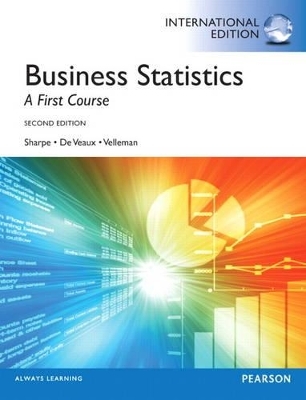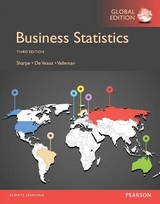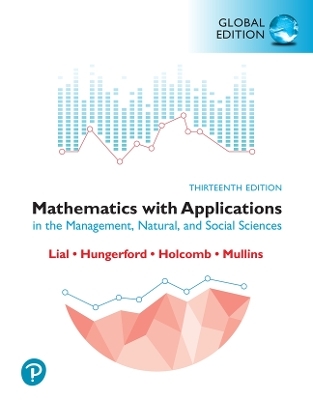
Business Statistics
Pearson
978-0-321-89429-8 (ISBN)
- Titel erscheint in neuer Auflage
- Artikel merken
The Second Edition provides a wealth of examples and exercises so that the story is always tied to the way statistics is used to make better business decisions. New to this edition are For Examples (illustrative examples), Section Exercises (single-concept exercises), and part-ending Case Studies (which are more in-depth than the Brief Cases located at the end of chapters). To help students become proficient with technology, the Second Edition includes instructions for JMP®, Minitab®, and SPSS®, as well as new and expanded coverage of Excel® 2010 and the add-in XLSTAT™ for Pearson. Screenshots of output are included throughout the chapters.
As a researcher of statistical problems in business and a professor at a business school, Norean Radke Sharpe (Ph.D. University of Virginia) understands the challenges and specific needs of the business student. She is currently teaching at the McDonough School of Business at Georgetown University, where she is also Senior Associate Dean and Director of Undergraduate Programs. Prior to joining Georgetown, she taught business statistics and operations research courses to both undergraduates and MBA students for fourteen years at Babson College. Before moving into business education, she taught statistics for several years at Bowdoin College and conducted research at Yale University. Norean is coauthor of the recent text, A Casebook for Business Statistics: Laboratories for Decision Making, and has authored more than 30 articles--primarily in the areas of statistics education and women in science. Norean currently serves as Associate Editor for the journal Cases in Business, Industry, and Government Statistics. Her research focuses on business forecasting and statistics education. She is also co-founder of DOME Foundation, Inc., a nonprofit foundation that works to increase Diversity and Outreach in Mathematics and Engineering for the greater Boston area. She has been active in increasing the participation of women and underrepresented students in science and mathematics for several years and has two children of her own. Richard D. De Veaux (Ph.D. Stanford University) is an internationally known educator, consultant, and lecturer. Dick has taught Statistics at a business school (The Wharton School of the University of Pennsylvania), an engineering school (Princeton University), and a liberal arts college (Williams College). He is an internationally known lecturer in data mining and is a consultant for many Fortune 500 companies in a wide variety of industries. While at Princeton, he won a Lifetime Award for Dedication and Excellence in Teaching. Since 1994, he has been a Professor of Statistics at Williams College, although he returned to Princeton for the academic year 2006–2007 as the William R. Kenan Jr. Visiting Professor of Distinguished Teaching. Dick holds degrees from Princeton University in Civil Engineering and Mathematics, and from Stanford University in Dance Education and Statistics, where he studied with Persi Diaconis. His research focuses on the analysis of large data sets and data mining in science and industry. Dick has won both the Wilcoxon and Shewell awards from the American Society for Quality and is a Fellow of the American Statistical Association. Dick is well known in industry, having consulted for such Fortune 500 companies as American Express, Hewlett-Packard, Alcoa, DuPont, Pillsbury, General Electric, and Chemical Bank. He was named the “Statistician of the Year” for 2008 by the Boston Chapter of the American Statistical Association for his contributions to teaching, research, and consulting. In his spare time he is an avid cyclist and swimmer. He also is the founder and bass for the Doo-wop group, “Diminished Faculty,” and is a frequent soloist with various local choirs and orchestras. Dick is the father of four children. Paul F. Velleman (Ph.D. Princeton University) has an international reputation for innovative statistics education. He designed the Data Desk® software package and is also the author and designer of the award-winning ActivStats® statistics package, for which he received the EDUCOM Medal for innovative uses of computers in teaching statistics and the ICTCM Award for Innovation in Using Technology in College Mathematics. He is the founder and CEO of Data Description, Inc. (www.datadesk.com), which supports both of these programs. He also developed the Internet site, Data and Story Library (DASL) (http://lib.stat.cmu.edu/DASL/), which provides data sets for teaching Statistics. Paul co-authored (with David Hoaglin) the book ABCs of Exploratory Data Analysis. Paul has taught Statistics at Cornell University on the faculty of the School of Industrial and Labor Relations since 1975. His research often focuses on statistical graphics and data analysis methods. Paul is a Fellow of the American Statistical Association and of the American Association for the Advancement of Science. Paul’s experience as a professor, entrepreneur, and business leader brings a unique perspective to the book. Richard De Veaux and Paul Velleman have authored successful books in the introductory college and AP High School market with Dave Bock, including Intro Stats, Fourth Edition (Pearson, 2014), Stats: Modeling the World, Third Edition (Pearson, 2010), and Stats: Data and Models, Third Edition (Pearson, 2012).
Preface
Index of Applications
PART I. EXPLORING AND UNDERSTANDING DATA
1. Stats Starts Here!
1.1 What Is Statistics?
1.2 Data
1.3 Variables
2. Displaying and Describing Categorical Data
2.1 Summarizing and Displaying a Single Categorical Variable
2.2 Exploring the Relationship Between Two Categorical Variables
3. Displaying and Summarizing Quantitative Data
3.1 Displaying Quantitative Variables
3.2 Shape
3.3 Center
3.4 Spread
3.5 Boxplots and 5-Number Summaries
3.6 The Center of Symmetric Distributions: The Mean
3.7 The Spread of Symmetric Distributions: The Standard Deviation
3.8 Summary—What to Tell About a Quantitative Variable
4. Understanding and Comparing Distributions
4.1 Comparing Groups with Histograms
4.2 Comparing Groups with Boxplots
4.3 Outliers
4.4 Timeplots: Order, Please!
4.5 Re-expressing Data: A First Look
5. The Standard Deviation as a Ruler and the Normal Model
5.1 Standardizing with z-Scores
5.2 Shifting and Scaling
5.3 Normal Models
5.4 Finding Normal Percentiles
5.5 Normal Probability Plots
Review of Part I. Exploring and Understanding Data
PART II. EXPLORING RELATIONSHIPS BETWEEN VARIABLES
6. Scatterplots, Association, and Correlation
6.1 Scatterplots
6.2 Correlation
6.3 Warning: Correlation ≠ Causation
6.4 Straightening Scatterplots
7. Linear Regression
7.1 Least Squares: The Line of "Best Fit"
7.2 The Linear Model
7.3 Finding the Least Squares Line
7.4 Regression to the Mean
7.5 Examining the Residuals
7.6 R2—The Variation Accounted for by the Model
7.7 Regression Assumptions and Conditions
8. Regression Wisdom
8.1 Examining Residuals
8.2 Extrapolation: Reaching Beyond the Data
8.3 Outliers, Leverage, and Influence
8.4 Lurking Variables and Causation
8.5 Working with Summary Values
Review of Part II. Exploring Relationships Between Variables
PART III. GATHERING DATA
9. Understanding Randomness
9.1 What is Randomness?
9.2 Simulating By Hand
10. Sample Surveys
10.1 The Three Big Ideas of Sampling
10.2 Populations and Parameters
10.3 Simple Random Samples
10.4 Other Sampling Designs
10.5 From the Population to the Sample: You Can't Always Get What You Want
10.6 The Valid Survey
10.7 Common Sampling Mistakes, or How to Sample Badly
11. Experiments and Observational Studies
11.1 Observational Studies
11.2 Randomized, Comparative Experiments
11.3 The Four Principles of Experimental Design
11.4 Control Treatments
11.5 Blocking
11.6 Confounding
Review of Part III Gathering Data
PART IV. RANDOMNESS AND PROBABILITY
12. From Randomness to Probability
12.1 Random Phenomena
12.2 Modeling Probability
12.3 Formal Probability
13. Probability Rules!
13.1 The General Addition Rule
13.2 Conditional Probability and the General Multiplication Rule
13.3 Independence
13.4 Picturing Probability: Tables, Venn Diagrams and Trees
13.5 Reversing the Conditioning and Bayes' Rule
14. Random Variables and Probability Models
14.1 Expected Value: Center
14.2 Standard Deviation
14.3 Combining Random Variables
14.4 The Binomial Model
14.5 Modeling the Binomial with a Normal Model
*14.6 The Poisson Model
14.7 Continuous Random Variables
Review of Part IV Randomness and Probability
PART V. FROM THE DATA AT HAND TO THE WORLD AT LARGE
15. Sampling Distribution Models
15.1 Sampling Distribution of a Proportion
15.2 When Does the Normal Model Work? Assumptions and Conditions
15.3 The Sampling Distribution of Other Statistics
15.4 The Central Limit Theorem: The Fundamental Theorem of Statistics
15.5 Sampling Distributions: A Summary
16. Confidence Intervals for Proportions
16.1 A Confidence Interval
16.2 Interpreting Confidence Intervals: What Does 95% Confidence Really Mean?
16.3 Margin of Error: Certainty vs. Precision
16.4 Assumptions and Conditions
17. Testing Hypotheses About Proportions
17.1 Hypotheses
17.2 P-Values
17.3 The Reasoning of Hypothesis Testing
17.4 Alternative Alternatives
17.5 P-Values and Decisions: What to Tell About a Hypothesis Test
18. Inferences About Means
18.1: Getting Started: The Central Limit Theorem (Again)
18.2: Gosset's t
18.3 Interpreting Confidence Intervals
18.4 A Hypothesis Test for the Mean
18.5 Choosing the Sample Size
19. More About Tests and Intervals
19.1 Choosing Hypotheses
19.2 How to Think About P Values
19.3 Alpha Levels
19.4 Practical vs. Statistical Significance
19.5 Critical Values Again
19.6 Errors
19.7 Power
Review of Part V From the Data at Hand to the World at Large
PART VI. LEARNING ABOUT THE WORLD
20. Comparing Groups
20.1 The Variance of a Difference
20.2 The Standard Deviation of the Difference Between Two Proportions
20.3 Assumptions and Conditions for Comparing Proportions
20.4 The Sampling Distribution of the Difference between Two Proportions
20.5 Comparing Two Means
20.6 The Two-Sample t-Test: Testing for the Difference Between Two Means
20.7 The Two Sample z-Test: Testing for the Difference between Proportions
20.8 The Pooled t-Test: Everyone into the Pool?
20.9 Pooling
21. Paired Samples and Blocks
21.1 Paired Data
21.2 Assumptions and Conditions
21.3 Confidence Intervals for Matched Pairs
21.4 Blocking
22. Comparing Counts
22.1 Goodness-of-Fit Tests
22.2 Chi-Square Test of Homogeneity
22.3 Examining the Residuals
22.4 Chi-Square Test of Independence
23. Inferences for Regression
23.1 The Population and the Sample
23.2 Assumptions and Conditions
23.3 Intuition About Regression Inference
23.4 Regression Inference
23.5 Standard Errors for Predicted Values
23.6 Confidence Intervals for
Predicted Values
23.7* Logistic Regression
Review of Part VI. Learning About the World
PART VII. INFERENCE WHEN VARIABLES ARE RELATED
24. Analysis of Variance
24.1 Testing Whether the Means of Several Groups Are Equal
24.2 The ANOVA Table
24.3 Plot the Data . . .
24.4 Comparing Means
25. Multiple Regression
25.1 Two Predictors
25.2 What Multiple Regression Coefficients Mean
25.3 The Multiple Regression Model
25.4 Multiple Regression Inference
25.5 Comparing Multiple Regression Models
Appendices
A. Answers
B. Photo Acknowledgments
C. Index
D. Tables and Selected Formulas
*Indicates an optional chapter
| Sprache | englisch |
|---|---|
| Maße | 216 x 271 mm |
| Gewicht | 1210 g |
| Themenwelt | Mathematik / Informatik ► Mathematik ► Finanz- / Wirtschaftsmathematik |
| Mathematik / Informatik ► Mathematik ► Statistik | |
| ISBN-10 | 0-321-89429-4 / 0321894294 |
| ISBN-13 | 978-0-321-89429-8 / 9780321894298 |
| Zustand | Neuware |
| Haben Sie eine Frage zum Produkt? |
aus dem Bereich



